Content
The chestnut tinder fungus (Polyporus badius) belongs to the Polyporov family, the genus Polyporus. A very remarkable spongy mushroom that grows to a large size. First described and classified as Boletus durus in 1788. Various mycologists have referred to it differently:
- Boletus batschii, 1792;
- Grifola badia, 1821;
- Polyporus picipes, 1838
At the end of the twentieth century, the chestnut tinder fungus was finally assigned to the genus Polyporus and received its modern name.
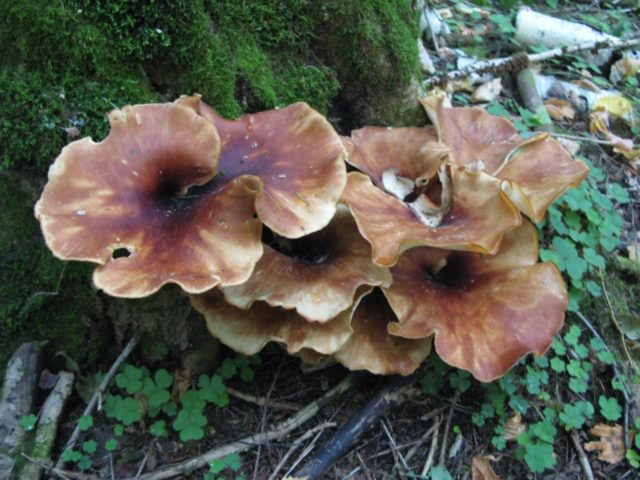
Like other Polypore, chestnut tinder fungus settles on wood
Description of chestnut tinder fungus
The fruit body has a rather attractive appearance. It looks especially impressive after rain or heavy dew - the bright hat literally shines like polished.
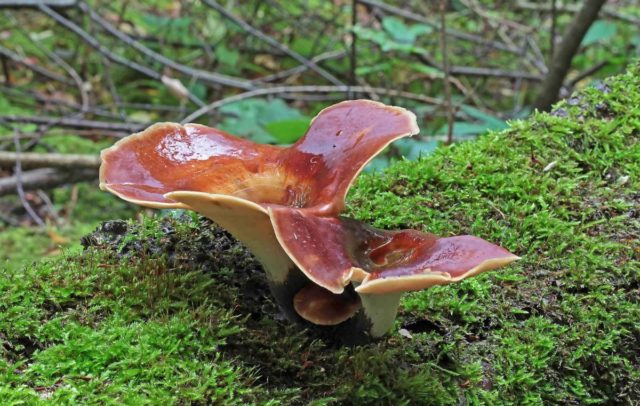
A little moisture often remains in the funnel-shaped depression
Description of the hat
Chestnut tinder fungus can have the most bizarre outlines: funnel-shaped, fan-shaped or petal. There are specimens in the form of an open saucer, a regular fringed circle with a depression in the center, eccentric ear-shaped or amorphous-wavy. The color is reddish-brown, dark chocolate, brownish-pinkish, olive-cream, gray-beige or milky honey. The color is uneven, darker in the center and light, almost white at the edge; it can change during the life of the fungus.
The fruit body reaches a very large size - from 2-5 to 8-25 cm in diameter. Very thin, with sharp, jagged or wavy edges. The surface is smooth, slightly shiny, satin. The pulp is tough, white or light brown in color, firm. Has a delicate mushroom aroma, almost tasteless. It is difficult enough to break it. In overgrown specimens, the tissue becomes woody, corky, rather brittle.
The geminophore is tubular, finely porous, unevenly descending along the pedicle. White, creamy pinkish or pale ocher colors. Thickness no more than 1-2 mm.
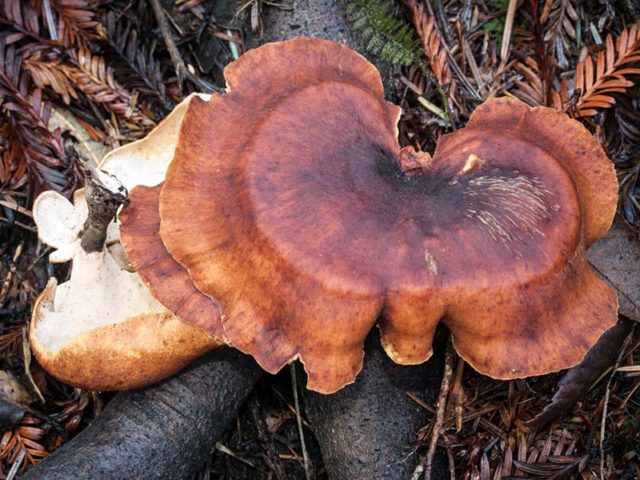
This specimen resembles an elephant's ear or an oriental fan.
Leg description
The chestnut tinder fungus has a relatively small thin stem. It is usually located in the center of the cap or shifted to one edge. Its length is from 1.5 to 3.5 cm, thickness is from 0.5 to 1.6 cm. Dark-colored, almost black. The color is uneven, lighter to the cap. Young mushrooms have a velvety pile, adult specimens are smooth, as if varnished.
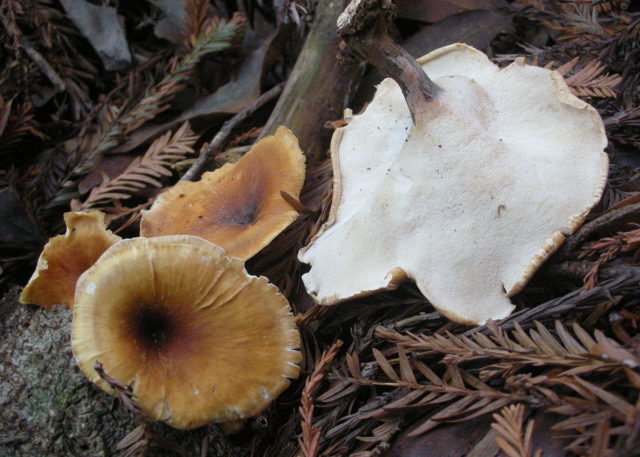
The leg is sometimes covered with a creamy pink coating
Where and how it grows
The habitat is quite extensive. You can meet the chestnut tinder fungus in the European part of Russia, in Siberia and the Far East, in Kazakhstan, in Western Europe, in the northern part of America and in Australia. Grows in single, rare groups in deciduous and mixed forests, in humid, shaded places.Prefers to settle on deciduous wood: alder, oak, poplar, phagus, willow, walnut, linden and others. It is extremely rare to find it on conifers.
It can develop both on a living tree and on dead wood, stumps, fallen and standing dead trunks. Quite often it is a neighbor of the scaly tinder fungus. Myceliums begin to bear fruit when the weather is warm, usually in May. Active growth is observed until the first frost at the end of October.
Is Chestnut Tinder Edible Or Not
Chestnut tinder fungus is classified as an inedible mushroom due to its low nutritional value and tough pulp. However, it does not contain toxic or poisonous substances in its composition.

Nutritional value is lacking in spite of the beautiful appearance
Doubles and their differences
Chestnut tinder fungus, especially young specimens, can be confused with some representatives of the genus Tinder fungus. However, the record size and characteristic color make these fruiting bodies one of a kind. He has no poisonous counterparts on the territory of Eurasia.
May tinder. Inedible, non-toxic. It is distinguished by a light color of the leg, the absence of a cannon on it.
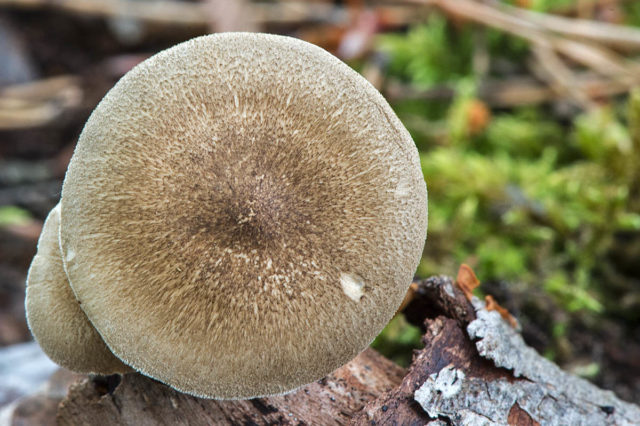
Its cap is noticeably covered with small brown scales and has an umbrella-like shape.
Winter polypore. Not poisonous, inedible. Differs in smaller size and larger, angular pores.
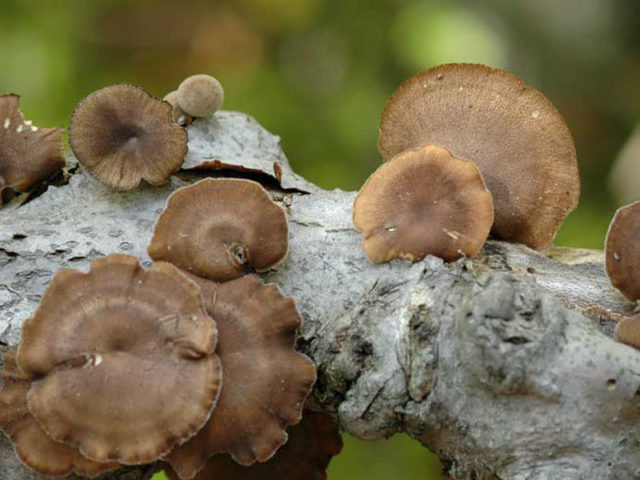
The color of the hat is closer to chestnut brown
Polyporus the black-footed. Inedible, non-toxic. Differs in violet-black coloration of the leg with grayish-silvery pubescence.
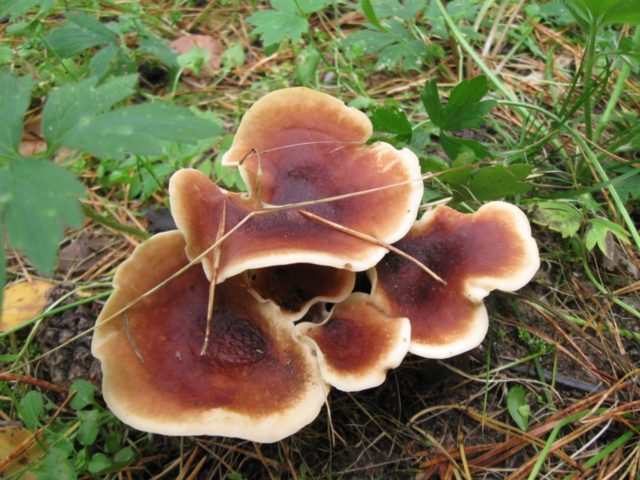
The cap has a distinct recess at the junction with the leg
Polyporus is changeable. Inedible, non-toxic. It has a thin long leg, silky smooth to the touch.
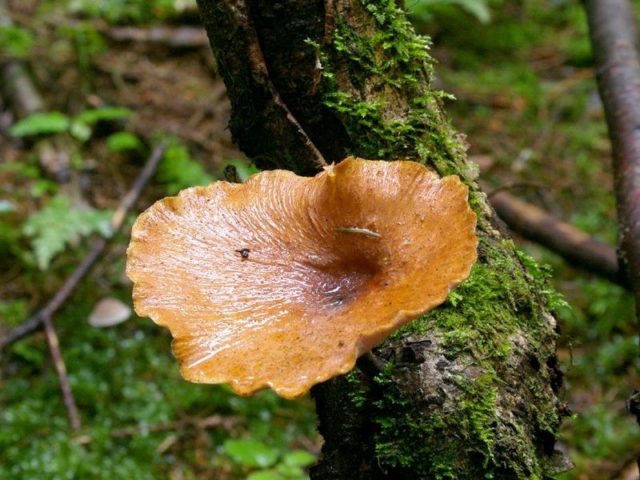
Funnel-shaped hat, bright brown, with radial stripes
Conclusion
Chestnut tinder fungus is quite widespread on all continents of the Earth. In favorable years, it bears fruit abundantly, covering trees and stumps with an original lacquer-shiny decoration from its fruit bodies. It grows both in small groups and singly. Inedible due to its low nutritional quality, it will not harm the body either. It has no poisonous twins, an inattentive mushroom picker can confuse it with some similar species of tinder fungus.








